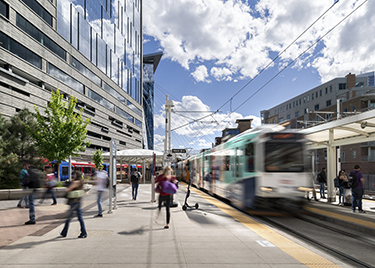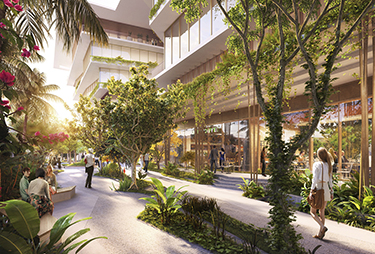|
Subscribe / Renew |
|
|
Contact Us |
|
| ► Subscribe to our Free Weekly Newsletter | |
| home | Welcome, sign in or click here to subscribe. | login |
Real Estate
| |
 |
July 30, 2020
Designing for a holistic community experience
Gensler

Haines
|
As architects, designers and urban planners, we play a critical role in influencing the future and enhancing the spaces of our cities through the design of sustainable, equitable, diverse and safe environments for all.
While this is certainly not a new concept, now more than ever we recognize the urgency to address the ongoing issues and vulnerabilities of our cities by conceptualizing and creating welcoming and inclusive spaces that fulfill our individual and collective needs. Although our needs will continue to evolve, their core foundation will require density, resilience and inclusivity.
Density
Strategically increasing the density of our cities provides greater opportunity for diversity — of people, public space, services and entrepreneurialism. Importantly, the interconnections between these are the vehicle for the understanding and appreciation of our fellow citizens.
The pandemic has shined a spotlight on our love of our local neighborhood favorites, influenced by our desire to be outdoors and safely fulfill our needs for goods and services. Proximity to a more comprehensive ecosystem of housing, employment, education, social interactions and respite — combined with access to key transit lines linking us to the larger context — will continue to be critical.
In the near term, however, the unfortunate association of our valuable transit systems with increased risk of infection will have us expecting more of this diversity to be closer to home.
While transit-oriented development (TOD) has begun to develop these types of ecosystems, most are not nearly diverse enough. Vancouver to the north has long provided examples of more varied mixed-use programming, while TOD in Puget Sound has taken a more single-use approach — providing the housing units so desperately needed, but with only minimal secondary uses and open space, instead of being overly optimistic in hoping adjacent properties will fill the gaps.
In order to prevent the continued placement of unremarkable and homogeneously programmed rowhouses from consuming the available redevelopment sites, these nodes of our city require study and planning at a district level, ensuring diversity is achieved to holistically serve their residents.
Resilience
As we’ve been forced to abandon indoor facilities during this pandemic, many of us are seeking open-air options and spaces for safely venturing from the confines of our homes to better air quality and physical exercise outdoors. That’s a lot of people suddenly gathering in our limited public spaces.
To help combat this, Seattle, Portland and other cities across the nation have closed off various neighborhood streets to permit only pedestrian and cycling access.
These pilots have allowed for equal and safe access to our open areas, green space, parks, greenways, and bike paths, mitigating potential risks brought on by overcrowded pathways and sidewalks.
Additionally, as we transition into the next phases of our businesses opening, some sidewalks and streets are being cordoned off — at least during designated times — to provide the expansion of outdoor restaurant seating and shopping. While these open spaces allow us more room to cohabitate, they are also providing valuable spaces that draw the community closer together.
Inclusivity
The inequity of voices being heard is stifling the progress of our cities to support our diverse citizenry. Existing public spaces are typically ill-equipped to host public discourse, and it is increasingly obvious how important it is that our city builders make this a priority. It’s critical that we start to purposefully create spaces that are open, equitable and safe, including zones designed for public discourse, ensuring all voices can be heard in a safe environment. As evident across the nation over the last several weeks, people are looking for spaces to congregate and be heard.
However, the designs of most cities are not conducive to the organized assembly of peaceful protesters needing a welcoming place for their collective voice to be heard. We need more open areas like plazas or parks equipped with speaking areas, ample room to accommodate large crowds, great visibility for safety management and strategic designs for the permeability of the edges — all with the intent to reduce the need for large security responses and the escalation that ensues.
It’s time to redouble our efforts to approach urban design as a flexible and adaptable model that can rapidly respond to our everchanging challenges. Just as diversity in the voices consulted to solve problems results in more ideas and better conclusions, curated diversity in the development of our cities will set us up to be a more resilient community able to thrive in the face of the unforeseen. We’re now poised to make the needed changes in our approach to create a holistic community experience for all. We have the ability and responsibility to lead the way.
Ryan Haines is the co-managing director of Gensler’s Seattle and Vancouver, B.C., offices. His 20-plus years of architectural experience encompasses an array of diverse projects including master planning, retail, transportation, workplace and government projects.
Other Stories:
- Sustainable satellites: Saviors of our cities?
- Design, science and the brain
- The evolution of urban development on First Hill
- Life science thrives in urban hubs
- Bold architecture blends with nature in the city
- A radical rebalancing of the urban environment
- Landscape architecture in the time of COVID-19
- Seattle’s march toward legacy city
- The coming evolution of cities and public spaces




